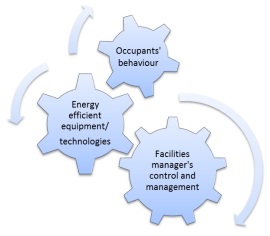
by Brianna Crandall — April 8, 2015—Non-domestic buildings in the United Kingdom are responsible for about a fifth of the country’s total carbon emissions, according to U.K.-based nonprofit building research and consultancy organization BSRIA (owned by The Building Services Research and Information Association), with similar figures in other countries.
Since the majority of existing buildings will still be in use by 2050, improving energy performance of existing buildings is important to help the country to meet their emission reduction targets. Peter Tse, senior design consultant, Sustainable Construction Group, BSRIA, has provided some useful tips below on how to help reduce carbon within an organization.
Energy can be saved by better control and management of the systems with the highest energy consumption, notes BSRIA. In non-domestic buildings, the installed heating, ventilation and air-conditioning system (HVAC) is normally the highest energy consumer. This is closely followed by lighting and small power loads such as computers, both of which are sources of internal heat gains.
To enhance energy performance of buildings in operation, operators and occupants have vital roles to play, adds BSRIA. The following list comprises low-cost or no-cost energy efficiency measures that operators can implement in their buildings. Some of these measures require occupants’ cooperation and will help encourage the desired behavior change.
According to BSRIA, energy can be saved by:
- Conducting regular energy audits to determine where and how energy is used in the building;
- Measuring HVAC weather-dependent energy consumption using degree days regularly to ensure systems are optimized for outdoor conditions;
- Ensuring proactive service and planned maintenance is in place for main HVAC components such as chillers, boilers and cooling equipment to maintain high operating-efficiency levels, including regular cleaning and replacement of filters;
- Adjusting thermostat set points to save on heating and cooling requirements; for example, a 1°C change can reduce fuel consumption by 8%;
- Implementing a continued energy awareness campaign for building users through e-mails, posters and meetings; energy champions can be nominated to support the campaign, provide greater engagement with users and conduct routine walk-arounds;
- Providing a simple user guide for occupants, for greater understanding of what building systems are available, how the systems work, and what the user interfaces are;
- Understanding how and where energy is used during unoccupied hours, since many non-domestic buildings have been found to have a significant base load out of hours;
- Ensuring any radiators and HVAC grilles are not blocked by users’ equipment or furnishings, to allow appropriate circulation within rooms;
- Ensuring that heated or cooled air does not escape from the building via windows left open, or leaky building envelope;
- Using energy-efficient lamps such as compact fluorescents (CFLs) or LEDs, which can provide operational savings, less heat output and longer life expectancies;
- Ensuring workstation allocation is aligned with the artificial lighting requirements of the work to remove the need for additional task lighting;
- Verifying that daylighting controls, presence detection and timers for lighting systems are set correctly to align with occupancy use;
- Checking whether any HVAC or lighting systems are being left running unnecessarily (for example the whole building being lit when only one floor is being cleaned at a time);
- Switching off any non-essential equipment such as computers, monitors, photocopiers and printers during unoccupied hours; and
- Monitoring energy use to improve understanding of when and where energy is being consumed, to support targeting of potential savings.





